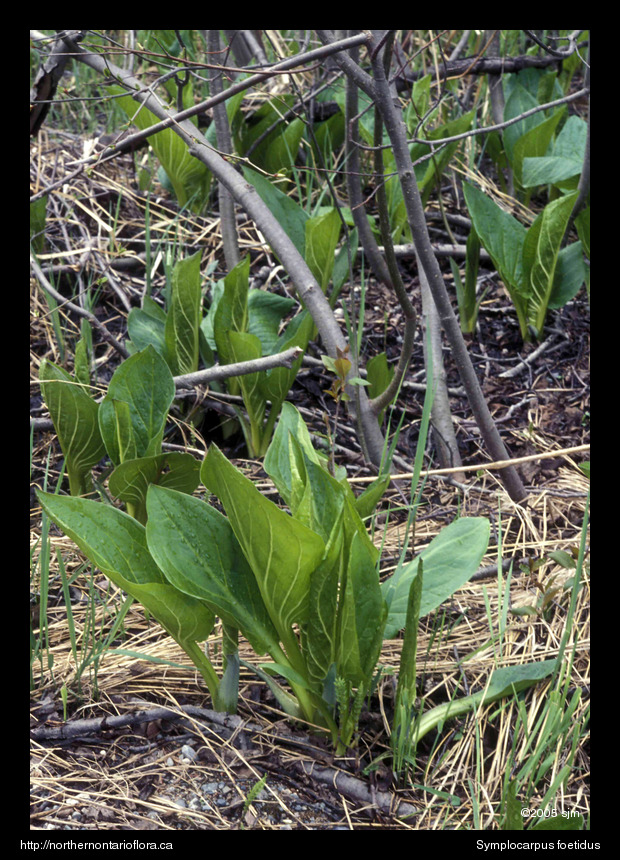
|
Northern Ontario Plant Database 
Plant DescriptionSymplocarpus foetidus (L.) Salisb. ex W.P.C. Barton 1817, nec Nutt. 1818En: skunk cabbage, eastern skunk cabbage, skunkweed, swamp cabbage, meadow cabbage, clumpfoot cabbage
Araceae (Arum Family) General: A perennial herb, to 6 dm tall, growing from a thick upright rhizome. Bruised or cut plants emit an unpleasant skunky odor. Leaves: Several per plant, basal, simple, petiolate, and pinnately-veined. The large leaf blades are ovate, smooth (glabrous), 3–6 dm long, and dark green when mature; leaf bases are rounded to cordate, apices pointed (acute) or blunt (obtuse), margins entire. Leaves emerge as flowering ends. Flowers: Each shoot bears a single inflorescence, close to the ground, in late March to early April. The inflorescence is composed of several small flowers tightly arranged on an ovoid axis (the spadix), which is enclosed within a short fleshy hooded spathe, 6–15 cm tall. Each bisexual flower has 4 fleshy yellowish to deep purple tepals, 4 stamens, and a single ovary with one ovule (embryonic seed). The outer surface of the spathe is streaked or mottled, greenish-yellow to deep purple; the spathe ends in a pointed apex that curves forward. Skunk cabbage plants are capable of generating their own heat (thermoregulation). The spongy tissue of the spathe and rhizome is metabolized to produce heat, which volatilizes chemicals that produce the unpleasant odour usually associated with pollinator attraction. The interior of the spathe can be up to 25°C higher than the surrounding air temperature. Recent research (Seymour & Blaylock 1999) has shown that increased temperatures within the spadix function more in protecting the developing flowers from temperature extremes than attracting pollinators. Flowers bloom in very early spring; the unopened spathes can be seen poking through the melting snow, with full blooming occuring in northern Ontario in early April. Fruit: Few plants produce fruits, but the occasional seeds that are produced (only 1 per ovary) are embedded within the thick spadix, forming an ovoid, aggregate-accessory fruit, 4–10 cm long. Fruits mature in summer. Habitat and Range: Wet woods and shores, stream banks, and alder thickets. Skunk cabbage is native to north-temperate eastern North America and eastern Asia. In Ontario, it extends as far north as Michipicoten Island, in northeastern Lake Superior, and Kaministiquia River in the Thunder Bay District. Internet Images: The Symplocarpus foetidus page from Connecticut Botanical Society. The Symplocarpus foetidus page from University of Wisconsin - Stevens Point. Selected References: Seymour, R.S., and A.J. Blaylock. 1999. Switching off the heater: influence of ambient temperature on thermoregulation by eastern skunk cabbage Symplocarpus foetidus. J. Exper. Bot. 50: 1525-1532. Knutson, R.M. 1974. Heat Production and Temperature Regulation in Eastern Skunk Cabbage. Science 186:746-747. Seymour, R.S. 1997. Plants That Warm Themselves. Scientific American March:104-109. – written by Susan J. Meades Back to species list |
||||||||||||||||||||||












